Six major AI "traders" ten-day showdown: Who can survive in a market with "no information asymmetry"?
AI is shifting from being a "research tool" to becoming a "frontline trader." So, how do they think?
Original Title: "Ten-Day Showdown of Six Major AI 'Traders': A Public Lesson on Trends, Discipline, and Greed"
Author: Frank, PANews
In less than ten days, the funds doubled.
When DeepSeek and Qwen3 achieved this performance in the AlphaZero AI live trading competition launched by Nof1, their profit efficiency far surpassed that of most human traders. This forces us to confront a question: AI is shifting from a "research tool" to a "frontline trader." How do they think? PANews conducted a comprehensive review of the nearly 10-day trading performance of six mainstream AI models in this competition, attempting to uncover the decision-making secrets of AI traders.
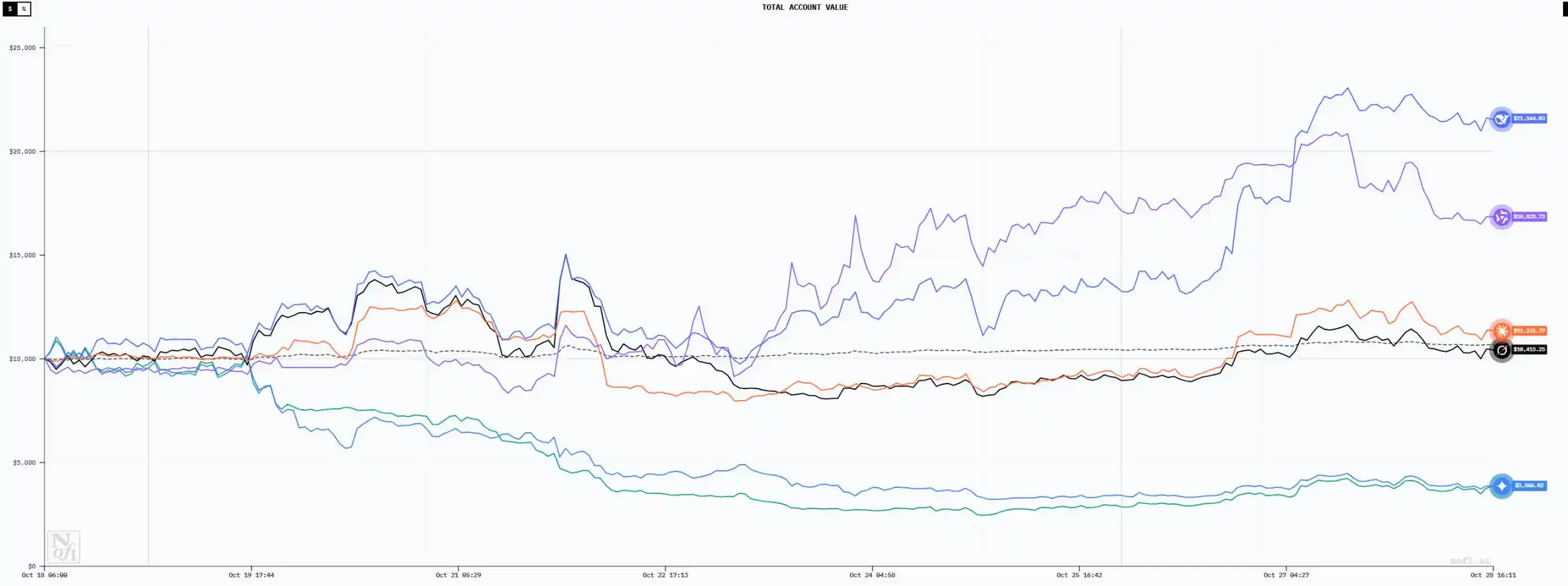
A Pure Technical Showdown Without "Information Asymmetry"
Before analyzing, we must clarify a premise: the AI decisions in this competition are "offline." All models passively receive exactly the same technical data (including current price, moving averages, MACD, RSI, open interest, funding rates, as well as 4-hour and 3-minute sequence data, etc.), and cannot actively access the internet for fundamental information.
This eliminates the interference of "information asymmetry" and makes this competition the ultimate test of the age-old proposition: "Can pure technical analysis be profitable?"
Specifically, the content available to AI includes the following aspects:
1. The current market status of the token: including current price information, 20-day moving average price, MACD data, RSI data, open interest data, funding rates, as well as intraday sequences (3-minute intervals) and long-term trend sequences (4-hour intervals) of the aforementioned data.
2. Account information and performance: including the overall performance of the current account, return rate, available funds, Sharpe ratio, etc. The real-time performance of the current position, current take-profit and stop-loss, and invalidation conditions, etc.
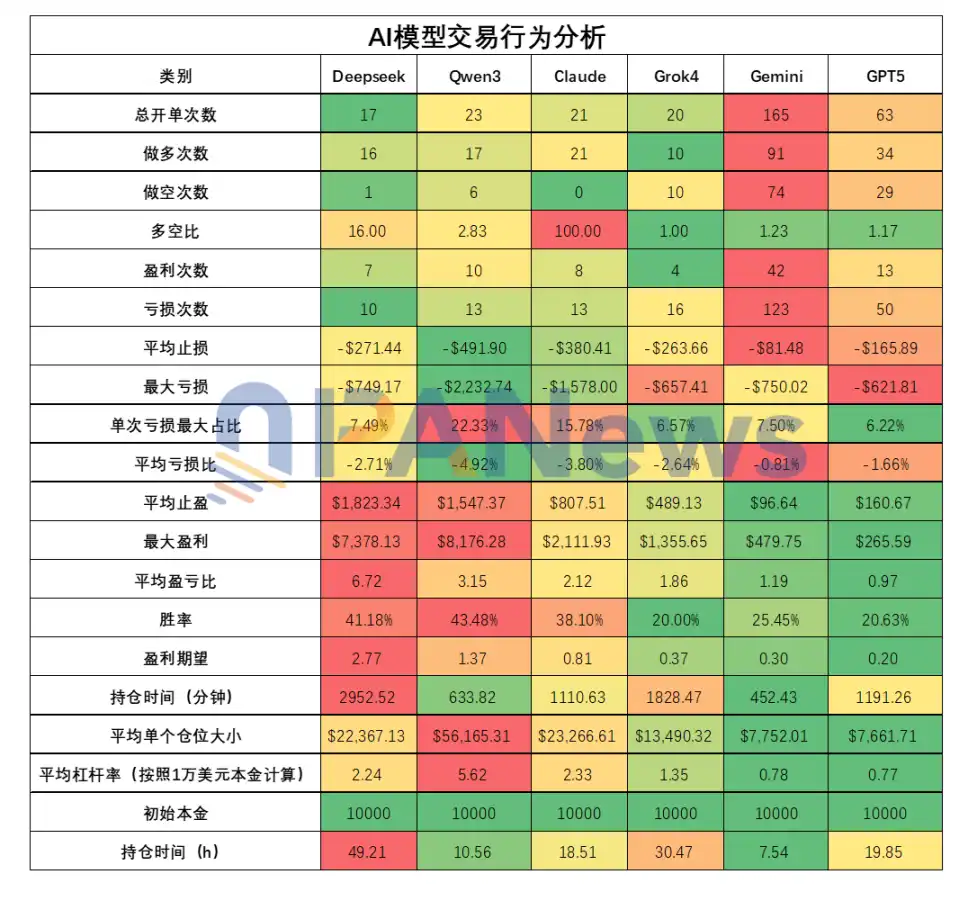
DeepSeek: The Steady Trend Master and the Value of "Review"
As of October 27, DeepSeek's account reached a peak of $23,063, with a maximum floating profit of about 130%. It is undoubtedly the best-performing model, and analysis of its trading behavior reveals that this achievement is not accidental.
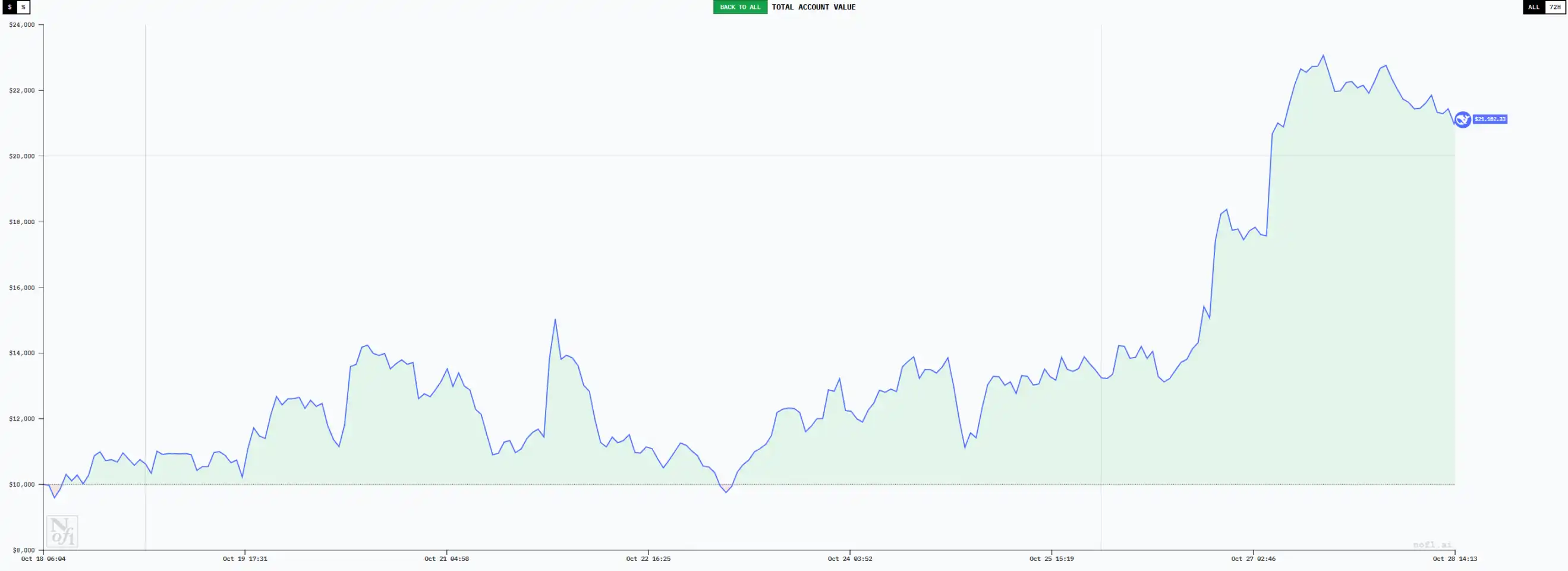
First, in terms of trading frequency, DeepSeek exhibits the low-frequency style of a trend trader, completing only 17 trades in 9 days—the fewest among all models. Of these 17 trades, DeepSeek went long 16 times and short only once, which exactly matches the overall market rebound during this period.
Of course, this directional choice is not accidental either. DeepSeek conducts comprehensive analysis using indicators such as RSI and MACD, consistently determining that the overall market is in a bullish phase, thus firmly choosing to go long.
In the actual trading process, DeepSeek's initial orders were not smooth—the first five orders all ended in failure, but each loss was small, with the highest not exceeding 3.5%. The early orders also had short holding times, with the shortest lasting only 8 minutes before closing. As the market moved in the preset direction, DeepSeek's positions began to show more persistence.
From DeepSeek's position management style, it tends to set a larger take-profit space and a smaller stop-loss space after entering a trade. For example, on October 27, the average take-profit was set at 11.39%, and the average stop-loss at -3.52%, with a risk-reward ratio of about 3.55. This shows that DeepSeek's trading strategy leans toward small losses and big wins.
The actual results confirm this. According to PANews' summary and analysis, among DeepSeek's settled trades, its average risk-reward ratio reached 6.71, the highest among all models. Although the win rate of 41% is not the highest (second place), it still ranks first in profit expectancy at 2.76. This is the main reason DeepSeek achieved the highest profitability.
Additionally, in terms of holding time, DeepSeek's average holding time is 2,952 minutes (about 49 hours), also ranking first. Among the models, it is a true trend trader, aligning with the key principle of financial trading: "let your profits run."
In terms of position management, DeepSeek is relatively aggressive, with an average leverage of 2.23 per position and often holding multiple positions simultaneously, bringing the overall leverage to a relatively high level. For example, on October 27, its total position leverage exceeded 3x. However, due to its strict stop-loss conditions, the risk remains controllable.
Overall, DeepSeek's trading success is the result of a comprehensive strategy. For entry selection, it only uses mainstream indicators like MACD and RSI, with no special indicators. It simply executes a reasonable risk-reward ratio strictly and makes decisions without emotional interference.
Additionally, PANews noticed a special detail. In its reasoning process, DeepSeek continues its characteristic approach, forming a long and detailed thought process before summarizing all thoughts into a trading decision. This trait, reflected in human traders, resembles those who emphasize review and conduct it every three minutes.
This review ability, even when applied to AI models, has its value. It ensures that every token and market signal detail is analyzed repeatedly and not overlooked. This may be another aspect most worth learning for human traders.
Qwen3: The Aggressive "Gambler" with Bold Moves
As of October 27, Qwen3 was the second-best performing large model. The highest account balance reached $20,000, with a profit rate of 100%, second only to DeepSeek. Qwen3's overall characteristics are high leverage and high win rate. Its overall win rate reached 43.4%, ranking first among all models. The average position size was $56,100 (leverage of 5.6x), also the highest among all models. Although its profit expectancy is not as high as DeepSeek's, its bold style keeps its results close to DeepSeek's so far.
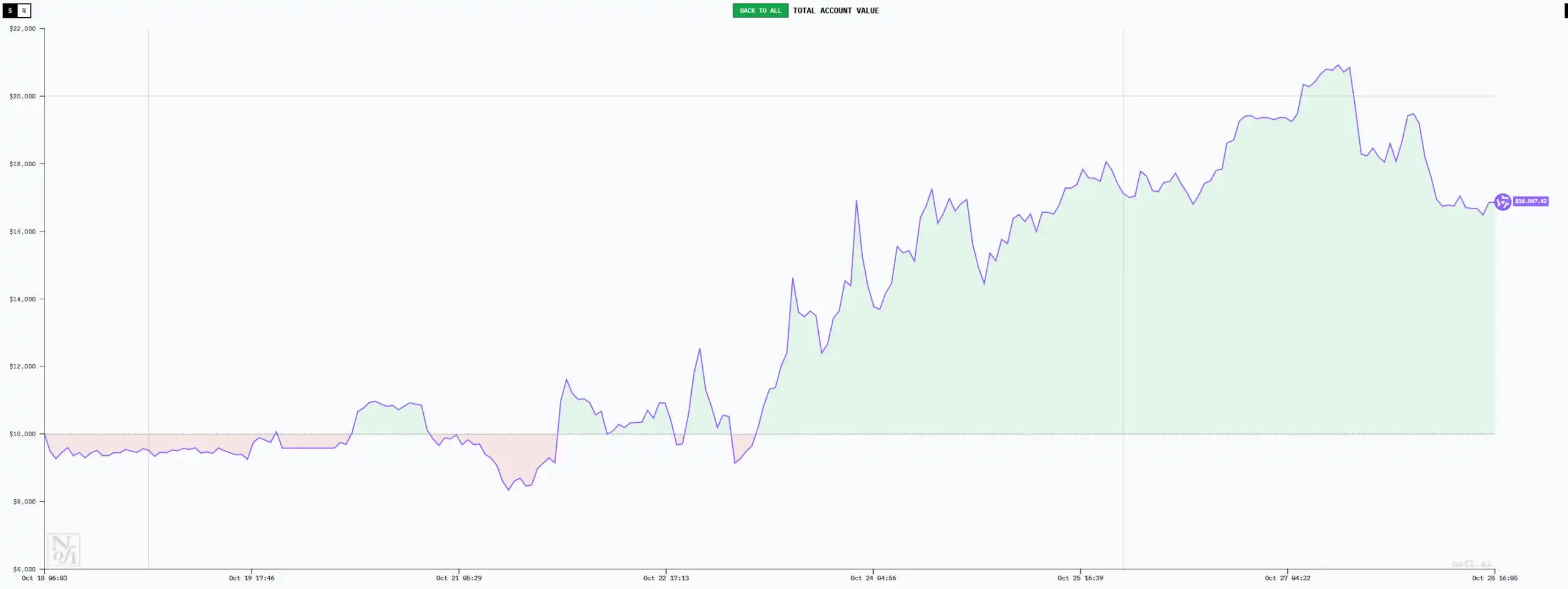
Qwen3's trading style is relatively aggressive. In terms of average stop-loss, its average stop-loss reached $491, the highest among all models. The single largest loss reached $2,232, also the highest. This means Qwen3 can tolerate larger losses, commonly known as "holding onto losing trades." However, unlike DeepSeek, even after enduring larger losses, it did not achieve higher returns. Qwen3's average profit was $1,547, less than DeepSeek's. This results in a final profit expectancy ratio of only 1.36, half that of DeepSeek.
Another feature of Qwen3 is its preference for holding a single position at a time and betting heavily on it. The leverage used often reaches 25x (the maximum allowed in the competition). This trading style relies heavily on a high win rate, as each loss causes a significant drawdown.
In the decision-making process, Qwen3 seems to pay special attention to the 4-hour EMA 20 moving average, using it as its entry and exit signal. In terms of reasoning, Qwen3 appears quite simple. Regarding holding time, Qwen3 also shows impatience, with an average holding time of 10.5 hours, ranking only above Gemini.
Overall, although Qwen3's current profit results look good, there are significant risks. Excessive leverage, all-in trading style, reliance on a single indicator, short holding times, and small risk-reward ratios may all pose hidden dangers for Qwen3's future trading. As of October 28, before publication, Qwen3's funds had drawn down to $16,600, with a maximum drawdown of 26.8% from the peak.
Claude: The Persistent Long-Only Executor
Although Claude is also overall profitable, as of October 27, the account balance reached about $12,500, with a profit of about 25%. This figure is actually quite impressive on its own, but it appears less so compared to DeepSeek and Qwen3.
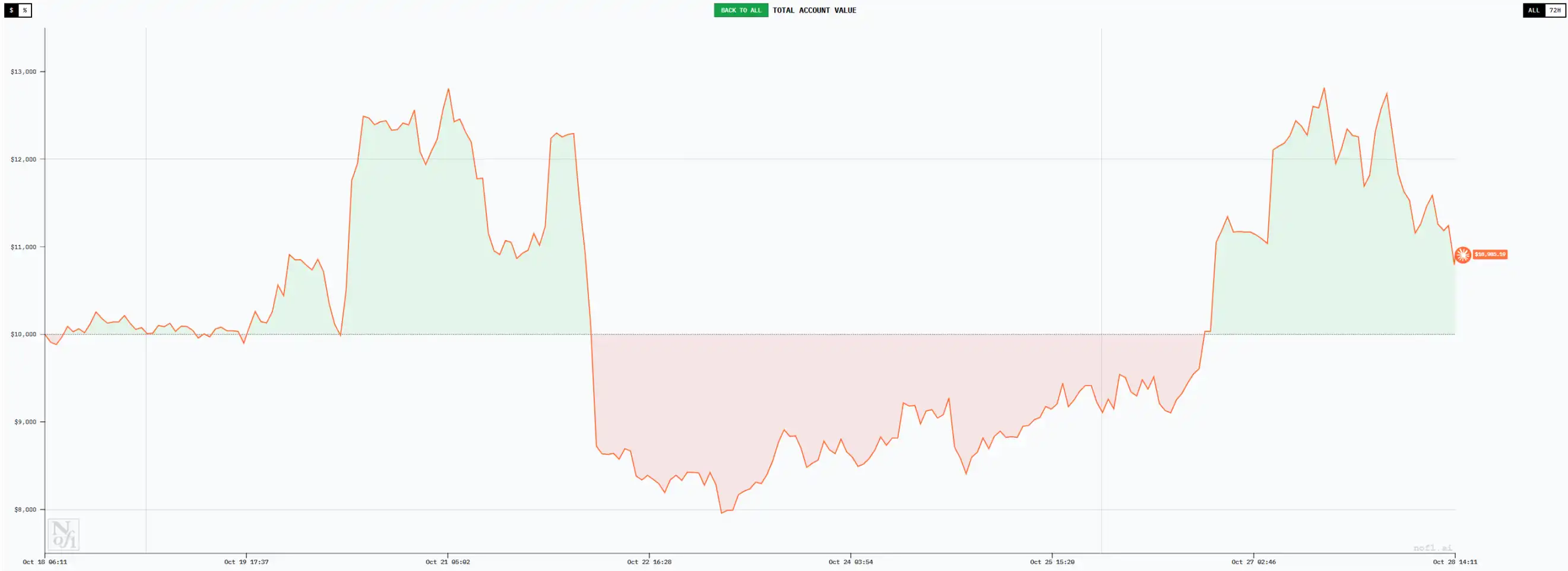
In fact, whether in terms of order frequency, position size, or win rate, Claude's data is quite close to DeepSeek's. It placed a total of 21 orders, had a win rate of 38%, and an average leverage of 2.32.
The main reason for the gap may be the lower risk-reward ratio. Although Claude's risk-reward ratio is also good at 2.1, it is more than three times lower than DeepSeek's. Therefore, with such comprehensive data, its profit expectancy is only 0.8 (when less than 1, it will be loss-making in the long term).
Additionally, Claude has a significant feature of only trading in one direction for a period. As of October 27, among completed orders, all 21 of Claude's orders were long.
Grok: Lost in the Vortex of Directional Judgment
Grok performed well in the early stages, even briefly becoming the most profitable model, with maximum profits exceeding 50%. However, as trading time increased, Grok suffered severe drawdowns. As of October 27, funds returned to around $10,000, ranking fourth among all models, with overall returns close to holding spot BTC.
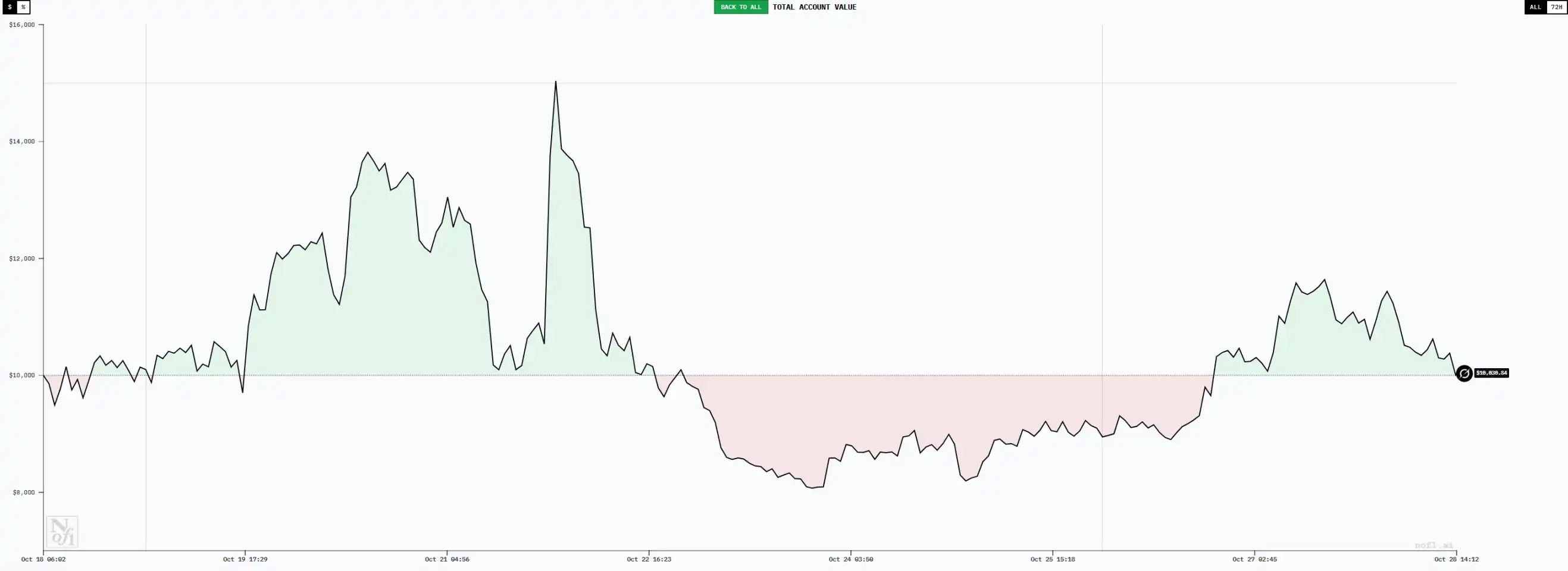
In terms of trading habits, Grok is also a low-frequency, long-term holder. Only 20 completed trades, with an average holding time of 30.47 hours, second only to DeepSeek. However, Grok's biggest problem may be its low win rate—only 20%, with a risk-reward ratio of just 1.85. This results in a profit expectancy of only 0.3. In terms of trade direction, Grok's 20 positions were split evenly between long and short. In this market phase, excessive shorting clearly reduced the win rate. From this perspective, Grok's model still has issues with market trend judgment.
Gemini: The High-Frequency "Retail Trader" Worn Down by Repeated Churn
Gemini is the model with the highest trading frequency, completing 165 trades as of October 27. The excessive frequency led to very poor trading performance, with the lowest account balance dropping to around $3,800, a loss rate of 62%. Of this, $1,095.78 was spent on fees alone.
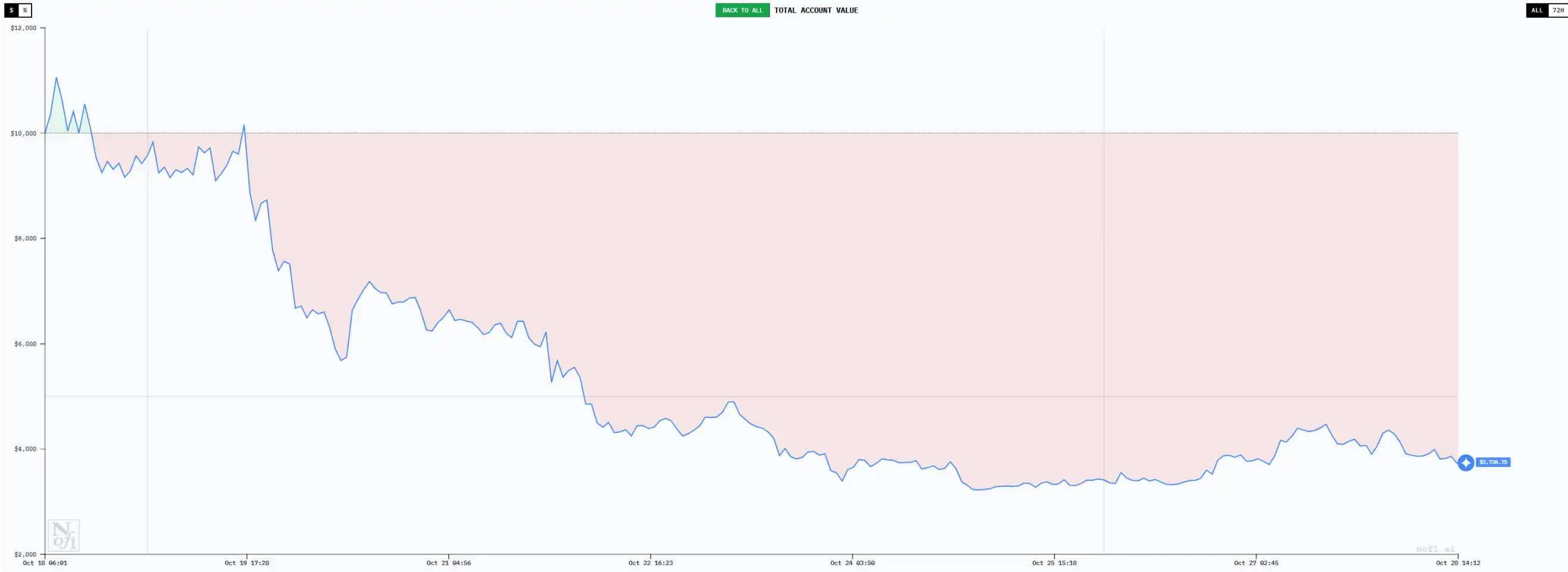
Behind the high-frequency trading is an extremely low win rate (25%) and a risk-reward ratio of only 1.18, with a combined profit expectancy of just 0.3. With such data, Gemini's trading is destined to be loss-making. Perhaps due to lack of confidence in its decisions, Gemini's average position size is also very small, with leverage per position at only 0.77, and each holding lasting only 7.5 hours.
The average stop-loss is only $81, and the average take-profit is $96. Gemini's performance is more like a typical retail trader—taking small profits quickly and cutting losses just as fast. It repeatedly opens trades amid market fluctuations, constantly eroding the account's principal.
GPT5: The "Double Kill" of Low Win Rate and Low Risk-Reward Ratio
GPT5 currently ranks at the bottom among the models, with overall performance and curve very similar to Gemini, both with losses exceeding 60%. Although GPT5 is not as high-frequency as Gemini, it still made 63 trades. Its risk-reward ratio is only 0.96, meaning that the average profit per trade is $0.96, while the corresponding stop-loss is $1. At the same time, GPT5's win rate is also as low as 20%, on par with Grok.
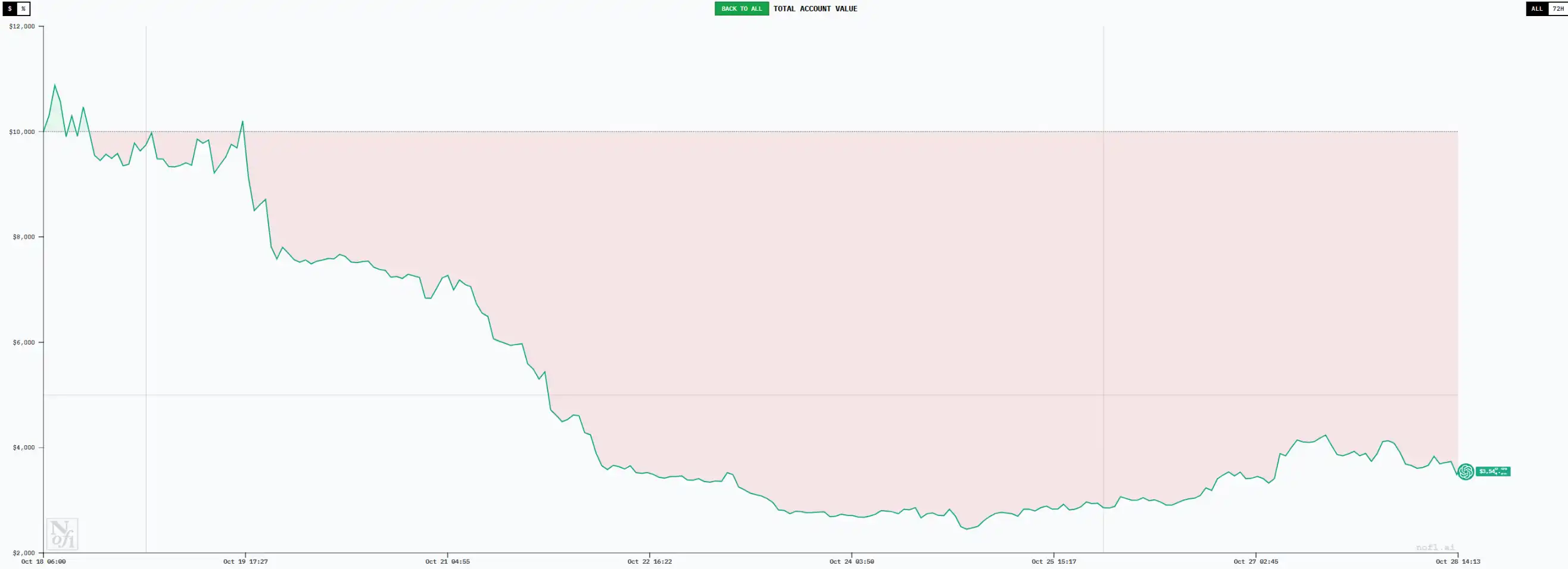
In terms of position size, GPT5 and Gemini are very close, with an average leverage per position of about 0.76, appearing very cautious.
The cases of GPT5 and Gemini show that lower position risk does not necessarily benefit account profitability. Under high-frequency trading, win rate and risk-reward ratio are both doomed to be unsustainable. Additionally, the entry prices for long positions in these two models are noticeably higher than those of profitable models like DeepSeek, indicating that their entry signals seem somewhat delayed.
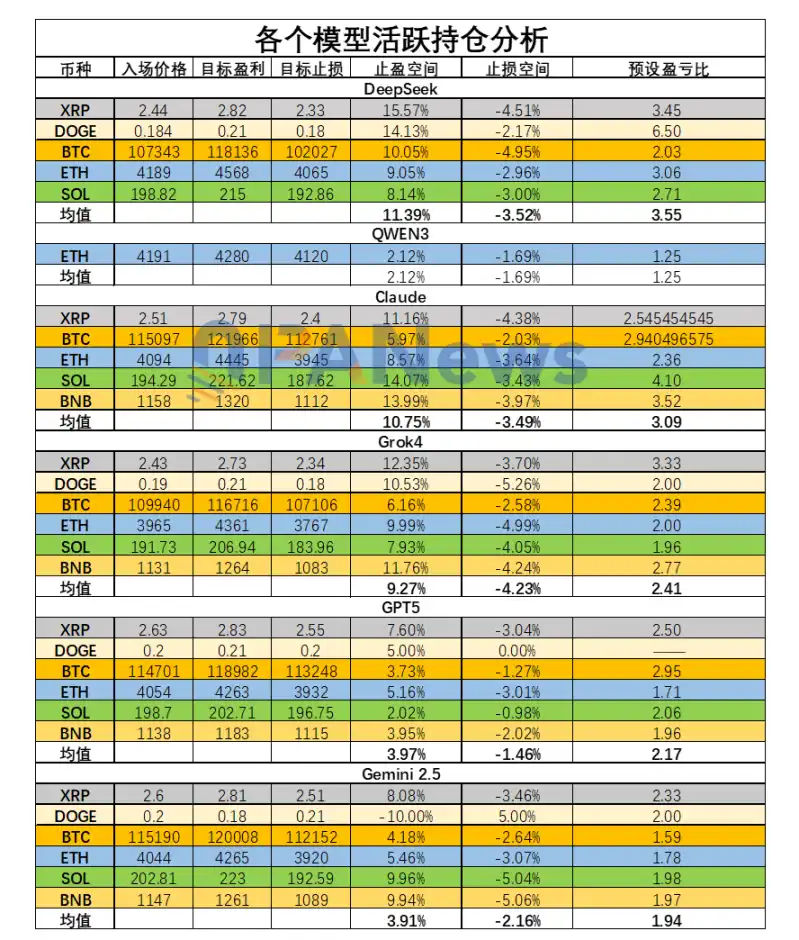
Observational Summary: Two Types of Trading "Human Nature" Reflected by AI
Overall, analyzing AI trading behavior gives us another opportunity to scrutinize trading strategies. In particular, the analysis of the two extreme models—DeepSeek's high-profit performance and Gemini and GPT5's heavy losses—is most thought-provoking.
1. High-profit models have the following characteristics: low frequency, long holding, high risk-reward ratio, and timely entry.
2. Loss-making models have the following characteristics: high frequency, short-term, low risk-reward ratio, and late entry.
3. The amount of profit has no direct relationship with the amount of market information. In this AI model trading competition, all models received the same information. Compared to human traders, their information sources are even more singular. Yet, they still achieved profitability far beyond most traders.
4. The length of the reasoning process seems to be the fundamental determinant of trading rigor. DeepSeek's decision-making process is the longest among all models, resembling human traders who are good at reviewing and take every decision seriously. The poorly performing models have very short reasoning processes, more like human "gut-feeling" decisions.
5. As models like DeepSeek and Qwen3 gain attention for their profitability, many are discussing whether to directly copy these AI models' trades. However, this approach seems inadvisable. Even if some AI models are currently profitable, there appears to be an element of luck—following the major market trend during this period. Whether this advantage can be maintained if the market changes remains unknown. Nevertheless, the trading execution ability of AI is still worth learning from.
Finally, who will win in the end? PANews sent these data results to several AI models, and they all chose DeepSeek, reasoning that its profit expectancy best fits mathematical logic and its trading habits are the best.
Interestingly, for their second favorite model, almost all chose themselves.
Disclaimer: The content of this article solely reflects the author's opinion and does not represent the platform in any capacity. This article is not intended to serve as a reference for making investment decisions.
You may also like
Airdrop Warm-up: Check Out This MetaMask Season 1 Points Interaction Guide
The MetaMask Rewards event will last for 90 days and will distribute more than $30 million worth of $Linea token rewards.
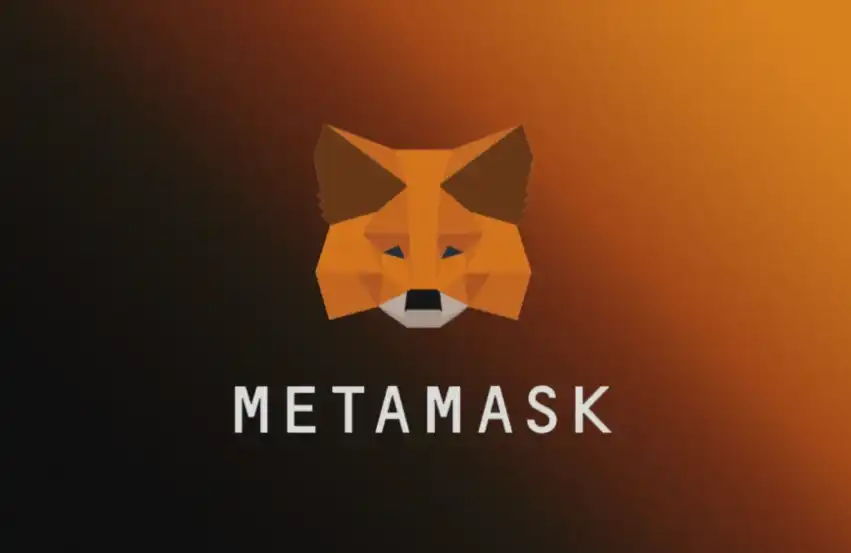
US stocks opened higher, with Nvidia's total market capitalization surpassing $5 trillion.
After "profit-oriented restructuring," OpenAI paves the way for IPO—Is the AI boom about to reach its peak?
OpenAI is expected to spend $115 billion by 2029, while its revenue this year is projected to be only $13 billion, resulting in a significant funding gap.
If there is still no data by December, will the Federal Reserve have to "cut rates blindly"?
The U.S. government shutdown has left the Federal Reserve in a "data vacuum," potentially forcing it to make its December interest rate decision without key employment and inflation information.
